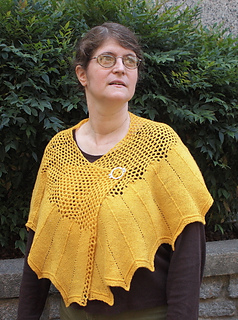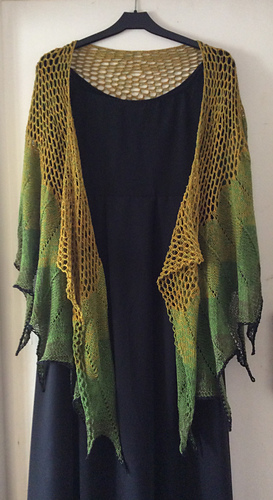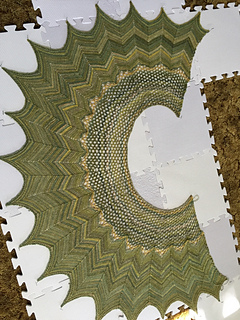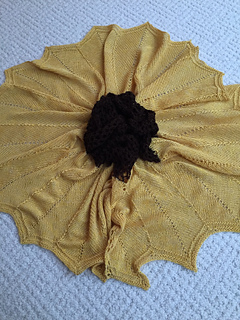patterns >  Gannet Designs and 1 more...
Gannet Designs and 1 more...
> Suffrage










Suffrage
When I decided to knit a shawl based on sunflowers, I really had no idea what I wanted to call it. Shortly after starting work on this shawl, it was International Women’s Day, and I was reminded that my great-grandmother had been a suffragist in Kansas as a teenager. While looking around on the internet for information about Kansas suffragists, I happened across the information that they used the Kansas sunflower as a symbol. The name for my shawl became obvious.
The shawl is shaped like a letter C: cast on a somewhat long inner edge, work honeycomb mesh outward for a while with some shaping, work a mildly complicated transition (with some patterning on two wrong side rows), finishing up with chevron petals. The outer edges have some garter stitch to counter curling. The petals can easily be made longer or shorter to accommodate different quantities of yarn.
Pattern has been professionally tech edited by Stephanie Boardman. Thanks also go to my test knitters!
Size:
- 14.5 inches (37cm) deep, 40 inches (102cm) along upper edge, 91 inches (2.3m) along longer edge
Gauge:
- stockinette: 28 sts and 35 rows over 4 inches (10cm).
- honeycomb: 18 sts and 40 rows over 4 inches (10cm).
Materials needed:
- 785 yards (718m) of light fingering yarn. Sample is worked in Cascade 220 Fingering, colorway 7827 Goldenrod.
- If knitting shawl in two colors: the mesh uses about 220 yards (200m) and the petals, 564 yards (515m). (about 28% / 72%)
- US size 4 (3.5mm) 40 inch (100cm) circular needle, or size needed to get gauge or the fabric you like. Working with a different gauge will change the size and how much yarn is needed, but can make for better results.
- Yarn needle for working in ends and seaming.
- 9 locking stitch markers. (Optional)
- 35 regular stitch markers. (Optional)
Techniques:
- You need to know how to work cable cast-on, yarnovers, double yarnovers, decreases, double increases, cables, and bind off.
- There are two wrong side rows that require more attention because of yarnovers, but otherwise all lace patterning is on right side rows. The mesh needs concentration and isn’t easily corrected from later rows.
- Both complete written instructions and complete charts (with some written notes) are provided.
- The repeats in the written instructions aren’t placed in the same locations as the repeats in the charts, though they will produce the same results.
Note: I am no longer able to set aside money for donations. Thanks for helping me donate $250!
14518 projects
stashed
16458 times
- First published: September 2016
- Page created: September 15, 2016
- Last updated: July 4, 2020 …
- visits in the last 24 hours
- visitors right now




